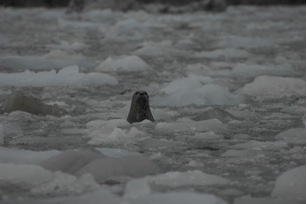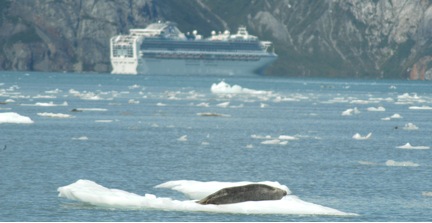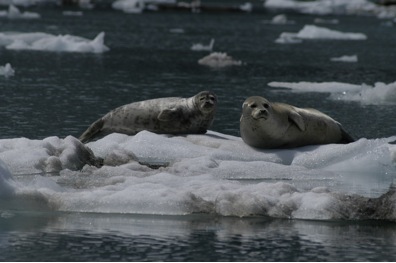
by Colleen Young, Vertebrate Ecology Lab
Am I talking about toilet-training harbor seals in Alaska? Although that would be fun and entertaining, I’m talking about flushing as a natural behavioral response. In behavioral ecology, flushing is defined as an animal leaving its resting location on land or ice and entering the water. The concept of flushing was the premise for the research I conducted for my Masters thesis.
My project was based on the general observation that wild animals tend to flee or flush in response to anthropogenic (human-caused) disturbances. Vessels like boats and kayaks are one of the greatest sources of disturbance to Pacific harbor seals (Phoca vitulina richardii).

Previous research indicated that the magnitude (how big) and frequency (how often) of the flush response in harbor seals was variable among vessel types, with non-motorized vessels like kayaks and canoes causing greater disturbance than motorized vessels. But most of those studies were based on harbor seals that haul out (come ashore) on land. What about seals that haul out on ice? Do they react in the same ways to different types of vessels?
To explore that question I recruited some volunteers and hopped on a plane to Glacier Bay National Park (GBNP), Alaska. GBNP is home top Johns Hopkins Inlet, a deep glacial fjord. Johns Hopkins glacier, at the head of the inlet, is one of the few glaciers that is actually advancing. Glaciers advance during winter when snow falls on the ice field behind the glacier, pushing the glacier forward. During summer, glaciers calve, or release large chunks of ice, which are called icebergs once they hit the water below. Icebergs provide floating platforms, which are used by harbor seals for resting, giving birth to pups, and molting (shedding old fur). Johns Hopkins Inlet was historically home to one of the greatest harbor seal aggregations in Alaska, and also is a popular destination for boaters and kayakers visiting GBNP, so it was a great place to study the impacts of vessels on ice-hauling seals.

After spending two summers camping in Johns Hopkins Inlet and conducting hours of observations on vessels and seals, I found that cruise ships caused the greatest magnitude of disturbance (i.e. flushed the most seals per encounter), but tour vessels caused disturbance more frequently. Kayakers caused a lower magnitude and frequency of disturbance than any other vessel type. This is different than previous research at terrestrial harbor seal haulout sites, which indicated non-motorized vessels caused greater magnitudes of disturbance than motorized vessels. Why would there be a difference in harbor seal response to vessels at ice vs. terrestrial sites? Why should we care? Stay tuned to find out!

